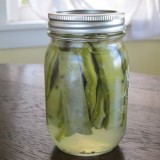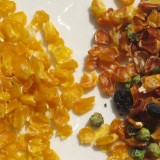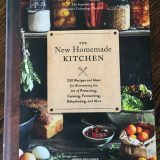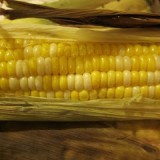Our neighborhood is full of loquat (Eriobotrya japonica) trees. For years I’ve been trying to figure out a way to use them. Loquats, a warm climate relative of the apple tree, produce tons of fruit all at once that do not keep well fresh. Thus the need to preserve the fruit. Unfortunately, they are also a chore to process–small large seeds and skins that are difficult to peel. They also vary widely in quality, since many in the neighborhood are probably seeds planted by birds and squirrels rather than grafted specimens.
But at last, I’ve found a use for them that’s relatively low-labor and yields a tasty result: loquat leather. Here’s the recipe I came up with:
2 cups loquats (no need to peel)
2 teaspoons lemon juice
2 teaspoons agave syrup
1 teaspoon triple sec
Remove seeds. Place loquats in a blender with the lemon juice, agave syrup and triple sec. Dehydrate at 135º until, as the Colorado Extension Service puts it, “translucent and slightly tacky to the touch, but easily peeled from the pan.”
Tips: Chef Ernie Miller suggested using a blender is rather than a food processor for this recipe. Also, try to spread the puree thicker towards the edges of the dehydrator sheet and you’ll get a more uniform result. Finally, the triple sec is optional, but some sort of flavor addition gives your fruit leather a more “adult” taste.
Fellow Master Food Preserver trainee Emily Ho is working on a loquat soda syrup and has also made some loquat jelly.






Once again, reading your blog is like going to another planet. Loquat trees? If the birds don’t get all of them, I’ll have blueberries in TWO months. The goats haven’t yet found a way into the veg garden and I harvested greens this week. Greens. Not fruit. Honestly, your stories of grapefruits and loquats right there in your backyard are just too much to believe. LA really is another world.
-Terry from the HenCam here in New England where there’s a chance of a hard frost until June 1)
So do you bother pulling out that inner membrane that’s wrapped around the seed? These fruits are indeed a pain in the rear to process. Fruit leather is a great idea, thanks!
Agree with you on the variation of fruit quality. They grow wild all over Silverlake, but I’d say only 1 out of every 4 or 5 trees is worth eating. There used to be a good tree in my parents’ backyard, but I believe it got “eaten” by the neighbor’s morning glory. Speaking of which, that might be an interesting post – plants that are perennial pests in California, but are treasured annuals in other parts of the country! Morning glory being at the top of my list. Conversely, I could never get mint to grow in LA unless I watered it every day…otherwise it’d just get crispy.
If you’re willing to wait a little while, the peppermint I planted several years ago here on the East Coast may just make it to your yard. One short rain shower and I swear it grows a foot.
Hey Rena,
No need to remove that inner skin–just too much work. The nice thing about fruit leather is that the marginal trees are still useful if you don’t mind tart leather or are willing to balance it out with a little more agave syrup. And, yes, an excellent idea for a post–how about all them damn ficus trees!
So, do you not peel them either?
I would like to add 4 o’clocks to the list of pests. I know they are annuals, but 1 plant 1 year equals 300 the next.
love the triple sec!
Palm tree =biiiig weed. Also, what do you mean “many small seeds”? Loquats do have 2-3 seeds, but they are huge (especially when compared to the size of the fruit).
I’ve used them for jam and painstakingly blanched them to remove their skin. I find the skin a little bitter and takes away from the sweet taste of the fruit but I might try leaving it on this year in the sake of labor saving
I am in zone 8b. About 10 years ago, I planted some seeds from my parents’ loquat tree, and this year was my first significant crop. I had lots, and, as you said, they don’t keep long. I used the applesauce-making attachment for my Kitchen Aid mixer, and all I had to do was remove the seeds and cut away any really bad places. I ended up with a puree that I made some delicious jam with (pectin+sugar included). It has a very exotic taste. I think I have just enough from a small second picking to try some leather.
Small seeds? ‘Quat you talkin’ ’bout, Willis! It’s more like ALL seeds. From the perspective of my backyard loquat the seeds (sometimes up to five per fruit) are pretty big in relation to the amount of edible flesh.
I just want to add that I think loquat seeds the prettiest fruit seeds of all (I’ll leave veg seeds as a different competitive category). When fresh, they’re all satiny and look like polished wood.
Thanks Will–I meant to say large seeds–post has been corrected.
My chickens live under our loquat trees and they love them. My next door neighbor has tons of rotting loquats, all we have are seeds, as they are eaten very quickly by the ladies.
Please don’t use agave nectar! It’s almost pure fructose, much worse for you than high-fructose corn syrup. Even worse, it drives up the cost of tequila!
Pingback: From the Archives: Loquat Leather | Root Simple